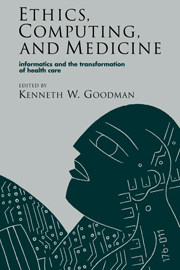Book contents
- Frontmatter
- Contents
- Preface
- List of contributors
- 1 Bioethics and health informatics: an introduction
- 2 Medical informatics and human values
- 3 Responsibility for computer-based decisions in health care
- 4 Evaluating medical information systems: social contexts and ethical challenges
- 5 Health care information: access, confidentiality, and good practice
- 6 Ethical challenges in the use of decision-support software in clinical practice
- 7 Outcomes, futility, and health policy research
- 8 Meta-analysis: conceptual, ethical, and policy issues
- Index
5 - Health care information: access, confidentiality, and good practice
Published online by Cambridge University Press: 12 November 2009
- Frontmatter
- Contents
- Preface
- List of contributors
- 1 Bioethics and health informatics: an introduction
- 2 Medical informatics and human values
- 3 Responsibility for computer-based decisions in health care
- 4 Evaluating medical information systems: social contexts and ethical challenges
- 5 Health care information: access, confidentiality, and good practice
- 6 Ethical challenges in the use of decision-support software in clinical practice
- 7 Outcomes, futility, and health policy research
- 8 Meta-analysis: conceptual, ethical, and policy issues
- Index
Summary
Privacy and confidentiality rights to nonintrusion and to enjoyment of control over personal information are so well known as to be regarded by some as obvious and beyond dispute. In unhappy fact, though, confidentiality protections are often meager and feckless because of the ease with which information is shared and the increasing number of people and institutions demanding some measure of access to that information. Health data are increasingly easy to share because of improvements in electronic storage and retrieval tools. These tools generally serve valid and valuable roles. But increased computing and networking power are changing the very idea of what constitutes a patient record, and this increases the “access dilemma” that was already a great challenge. The challenge may be put as follows: How can we maximize appropriate access to personal information (to improve patient care and public health) and minimize inappropriate or questionable access? Note that “personal information” includes not only electronic patient records, but also data about providers – physicians, nurses, and others – and their institutions. This chapter reviews the foundations of a right to privacy and seeks out an ethical framework for viewing privacy and confidentiality claims; identifies special issues and problems in the context of health computing and networks; considers the sometimes conflicting interests of patients, providers, and third parties; and sketches solutions to some of the computer-mediated problems of patient and provider confidentiality.
- Type
- Chapter
- Information
- Ethics, Computing, and MedicineInformatics and the Transformation of Health Care, pp. 75 - 101Publisher: Cambridge University PressPrint publication year: 1997
- 1
- Cited by



